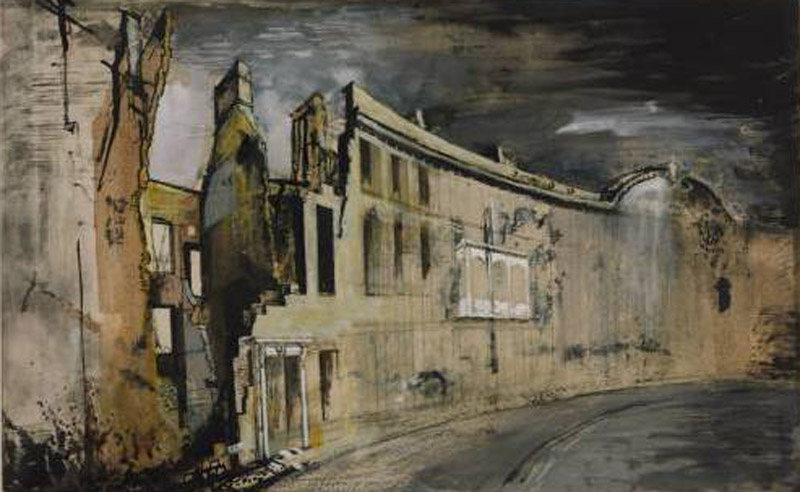 An article about Graham Sutherland’s bequest of art to Wales (The Jackdaw, no. 90) raised a number of points which further research has – partially – answered. To recap: Sutherland donated work to a purpose-formed Graham Sutherland Trust (the “Trust”) in 1976, which displayed the art in a gallery housed in Picton Castle, Pembrokeshire. When the cost of maintaining the gallery became unsupportable the Bequest was transferred to the National Museum of Wales (“NMW”).
An article about Graham Sutherland’s bequest of art to Wales (The Jackdaw, no. 90) raised a number of points which further research has – partially – answered. To recap: Sutherland donated work to a purpose-formed Graham Sutherland Trust (the “Trust”) in 1976, which displayed the art in a gallery housed in Picton Castle, Pembrokeshire. When the cost of maintaining the gallery became unsupportable the Bequest was transferred to the National Museum of Wales (“NMW”).
Recently, I was able to view some of the works on paper and key documentation relating to the Trust at NMW in Cardiff. Items in the original Marlborough Gallery frames are kept in those frames; loose material is now stored in archive boxes. One box contained landscape sketches on perforated sheets from sketchbooks. These pages were mostly early (1930s), largely drawn in black ink with a fine nib and given washes of ink, watercolour or dilute oil (or a combination of those). Some of them were squared for transfer. Another box held sketches from Sutherland’s time as a war artist and showed the ruined Masonic Hall in Swansea and buildings in and around Cardiff. Some were versions of the same composition. Many were coloured pungent acid and moss greens, purple and pink. These sheets, a mere handful, demonstrate the excellent quality of some of NMW’s Sutherland collection. Unfortunately, it is not easy to ascertain which articles came via the Bequest, the Ministry of War or NMW acquisition, something that ongoing research by Rachel Flynn will establish.
Viewing the contents of the archive (including Sutherland’s will and the 1989 agreement between the Trustees and NMW) demonstrates how convoluted the tale of the Sutherland Bequest is. We can now flesh out a basic timeline. Sutherland deeded the original Bequest (valued at £500,000) to the Trust on February 12th, 1976. The Trust comprised a number of distinguished figures, including Lord Goodman and Ronald Alley; others were representatives of local municipalities. The driving force behind the running of the Trust was Gordon Bennett MBE, a retired civil engineer and friend of the artist. The lease of part of Picton Castle began on June 9th, 1976. It opened to the public on June 18th, 1976. By 1978, repair, alteration and maintenance of the property had cost £80-90,000.
What is obvious from studying the archive is that at the conception of the Bequest, NMW was seen as playing an active part in the custodianship and promotion of the gallery and NMW was a signatory in various agreements during the 1970s. From the beginning the project was hamstrung by critical divisions between the Trust, NMW, local council authorities and the owners of Picton Castle (the “Landlords”). Additionally, ticket revenues for castle and gallery (both charged entry fees) were never combined and opening hours not coordinated, confusing visitors and sparking protracted negotiation between Trustees and Landlords. Sutherland died in February 1980, leaving everything to his wife. The Trust is not mentioned in his will. During September 1980 the Trust severed links with NMW.
The chronic financial problems of the Trust deepened over the 1980s, relying as it did on a combination of donations, entry revenue and merchandise profits. The relatively remote location severely limited the contribution of the latter two components. Urgent deliberation began to find a solution. Two clear-cut options were complete dispersal of the Bequest by auction and assigning the Bequest to NMW. Trustees could delay no further: the Charity Commission stated in no uncertain terms that the Trust, a charitable body, could not be allowed to function insolvent. By 1989, save for certain sums inextricably committed to particular minor projects, the Trust was effectively bankrupt. Minutes record that at a board meeting on June 11th, 1989 Trustees authorised unconditional transfer of all art and some other properties to NMW.
NMW signed a five-year extension to the lease of the Picton Castle gallery in 1989. The intention was to streamline the gallery, reduce property rented (some of which had become dangerously dilapidated) and manage from Cardiff while maintaining the Bequest and gallery in the original forms. This proved unworkable and the gallery closed in October 1995. Abolition of entry fees to museums has since limited NMW’s room for manoeuvre regarding a dedicated gallery in Pembrokeshire for the Bequest. Current developments (cataloguing by NMW and Ms Flynn and a planned public database of all works in the collection) combined with the current regime of exhibiting canvases on a near permanent basis at Oriel y Parc, St. David’s alongside a rotating selection of works on paper, seem a viable, though imperfect, response to the troubled legacy of the Sutherland Bequest.
The author wishes to thank Oliver Fairclough, Keeper of Art, NMW, for his assistance in the preparation of this article.
Alexander Adams is an artist and writer based in Berlin.
The Jackdaw May-Jun 2011